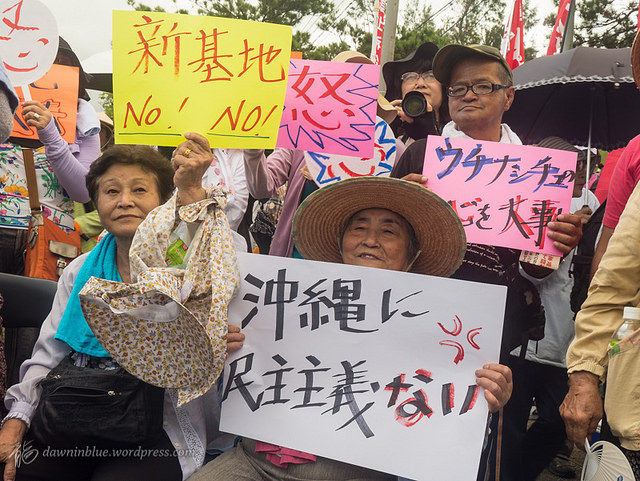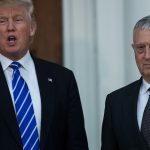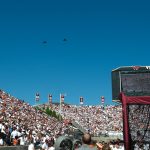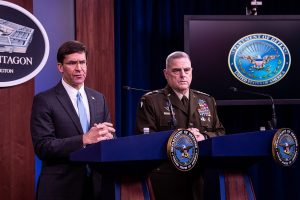by Tim Shorrock
Okinawa Gov. Takeshi Onaga arrived at the National Press Club last Friday to address the media after spending three days in Washington talking about his opposition to a new U.S. Marine base on the island.
What might have been a hopeful message turned into disappointment when word came in of meetings held in Tokyo that same day between Secretary of Defense Jim Mattis and the government of Shinzo Abe.
Directly addressing the Okinawa question, Mattis and Defense Minister Tomomi Inada agreed that a decade-old pact to reduce US Marine operations at Futenma Air Base by building a new facility at Henoko Bay near the city of Nago was “the only solution” to the dispute.
Without even a nod to Onaga and the powerful opposition movement he represents, Mattis and Inada cut off all chances that construction at Henoko might be delayed so the two governments could work out an agreement that took into account Okinawa’s grievances.
“That is unfortunate [and] extremely rude to islanders,” said Onaga in his opening statement in Washington. “If both sides stick to the view that Henoko is the only solution to resolving” the Futenma issue, “the U.S.-Japan relationship will be unresolved, leaving serious problems in the future.”
Visibly angry, Onaga added that “Okinawa’s patience has its limits.” The people of Okinawa “are united as one” against the US Marine presence and “our solidarity will become stronger,” he vowed.
“Okinawa governor’s trip to DC couldn’t have gone much worse: shunned by Trump admin and upstaged back home,” Anna Fifield, the Washington Post’s Tokyo correspondent, tweeted over the weekend.
The Mattis-Inada statement was also disappointing because Onaga had met a wide range of US officials early that week at the National Prayer Breakfast where Trump also spoke. During the breakfast, he said that he introduced himself to Secretary of State Rex Tillerson and met four congressmen. Compared to earlier trips, Onaga said that he felt that people in Washington “share a flexible attitude and listened.”
But once it was clear that Trump and Abe were on the same page on the US Marine presence, many of his interlocutors told him “nothing can be done.”
Onaga noted that Abe would be in Washington on February 10 for his second visit to Trump since the election. He speculated that Japan was trying to rush through an understanding on Okinawa so the two leaders can move on to improve U.S.-Japan ties through a bilateral trade agreement and other steps (during their visit, the two leaders are planning a round of golf, “which is a great thing,” Trump said Sunday).
“There’s a lot of anxiety [in Okinawa] that the Japanese government is in a hurry over this issue,” Onaga said. Futenma has been problematic for years because of its proximity to the crowded city of Ginowan. But the expansion at Henoko is widely seen in Okinawa as a social and environmental disaster that will ruin a pristine coastal area known for its coral and sea life.
This was Onaga’s third visit to Washington in two years, and his delegation included five members of Okinawa’s prefectural government and the mayor of Nago City. During the week, Onaga also met with 13 members of Congress. Other members of the delegation sat down with activists in the US peace movement, including members of Code Pink and organizers at the Institute for Policy Studies.
Meanwhile, protestors from Okinawa held demonstrations at the White House and the Pentagon, with banners reading “Protect Henoko” and “Enough is Enough: All US Bases Out of Okinawa—End 72 years of Military Occupation.”
On Friday, just before his press conference, Onaga met with Joe Young, director for Japanese affairs at the State Department, and Paul Vosti, the acting director for Japan in the Pentagon office of the undersecretary of defense for policy. In those sessions, the US officials “reiterated the United States’ unwavering commitment” to building a replacement facility in Henoko, the State Department said.
In response, Onaga said he stressed that construction at Henoko could take 10 to 15 years, and denounced the Abe government for mobilizing hundreds of riot police against opponents of the bases. “The Japan-US alliance is there to protect freedom, human rights, and democracy,” he told reporters. “But if the government proceeds with the construction and the opposition [is stifled], this security arrangement will be damaged.”
That’s exactly what happened upon his return. On February 6, the Abe government began the initial construction for the Marine base in the waters off of Henoko, “marking a major step to relocate U.S. Marine Corps Air Station Futenma from the prefecture’s Ginowan,” Asahi reported.
A day later, the newspaper issued a stinging editorial condemning the action. Abe’s decision “to embark on offshore work at this time apparently reflects its strong desire to win favor with the new administration of President Donald Trump,” the prominent daily stated.
As the Japanese ships prepared to drop concrete blocks to the ocean floor, about 100 protesters “clashed with riot police officers in front of U.S. Marine Corps Camp Schwab, located ashore from the site, when four dump trucks arrived shortly past 9:30 a.m,” the newspaper said. “The activists attempted to stage a sit-in to block the entry of the vehicles, but were forcibly removed by riot police officers. Shouts of ‘Let us go,’ and ‘stop police brutality,’ were heard from protestors as they were dragged away by police.”
One of those protesting was Nago Mayor Susumu Inamine, who had accompanied Onaga on his visit to Washington. “It is our national government that keeps completely ignoring our opinions,” he told the Mainichi.
The Okinawan opposition to one of America’s most important overseas bases, however, seems to draw little interest from the U.S. media. Of the two dozen reporters at Onaga’s press conference, only one was from the United States. Moreover, Onaga’s visit and his pleas for the United States to respect Okinawa’s human rights didn’t get a single mention in the US media.
Photo of protesters in Okinawa by RyuFilms via Flickr.






Sometimes being one of Washington’s top vassal states really sucks.